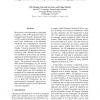Free Online Productivity Tools
i2Speak
i2Symbol
i2OCR
iTex2Img
iWeb2Print
iWeb2Shot
i2Type
iPdf2Split
iPdf2Merge
i2Bopomofo
i2Arabic
i2Style
i2Image
i2PDF
iLatex2Rtf
Sci2ools
ACL
2007
2007
Bilingual-LSA Based LM Adaptation for Spoken Language Translation
We propose a novel approach to crosslingual language model (LM) adaptation based on bilingual Latent Semantic Analysis (bLSA). A bLSA model is introduced which enables latent topic distributions to be efficiently transferred across languages by enforcing a one-to-one topic correspondence during training. Using the proposed bLSA framework crosslingual LM adaptation can be performed by, first, inferring the topic posterior distribution of the source text and then applying the inferred distribution to the target language N-gram LM via marginal adaptation. The proposed framework also enables rapid bootstrapping of LSA models for new languages based on a source LSA model from another language. On Chinese to English speech and text translation the proposed bLSA framework successfully reduced word perplexity of the English LM by over 27% for a unigram LM and up to 13.6% for a 4-gram LM. Furthermore, the proposed approach consistently improved machine translation quality on both speech and ...
ACL 2007 | BLSA Framework | Computational Linguistics | Crosslingual Lm Adaptation | Language N-gram Lm |
| Added | 29 Oct 2010 |
| Updated | 29 Oct 2010 |
| Type | Conference |
| Year | 2007 |
| Where | ACL |
| Authors | Yik-Cheung Tam, Ian R. Lane, Tanja Schultz |
Comments (0)

